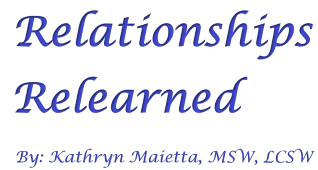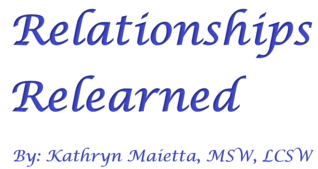Comments from Kathryn, the author of this blog and a licensed clinical social worker. It is so difficult to know what is real anymore. Is the information you receive disinformation, misinformation, malinformation or real information? If you watch a movie, you know it is fantasy. When you watch a video on Tik Tok, do you think it is real? Or, do you question whether it has been altered?
When you see a picture on social media of an actor with a perfect physique, do you assume it is how they look in real life? Or, do you question whether someone has airbrushed the photo?
When you listen to someone reporting on the events of the day, do you assume the information is based on fact and presented without bias? Or, do you question what is presented is actually misinformation, disinformation and/or malinformation?
If you question what you see and hear, you are not paranoid.
Misinformation, disinformation and/or malinformation is nothing new. It has been around for centuries. According to Commonsense.org, in 1782 Benjamin Franklin created a fake issue of a Boston newspaper to build sympathy for the American Revolution. The Boston newspaper claimed that the Brits hired Native Americans to scalp soldiers and civilians. The false information was then widely circulated by other newspapers, increasing public hostility toward Native Americans. https://www.commonsense.org/sites/default/files/pdf/2017-08/newsmedialit-fakenewstimeline-85×11.pdf
Are there really new concepts in the world?
Information
Dictionary.com describes the word information as knowledge communicated or received concerning a particular fact or circumstance; news.
Information relays facts or specific details about a subject. Pure information is fair and free from bias.
Misinformation
Dictionary.com defines misinformation as false information that is spread, regardless of whether there is intent to mislead.
Examples of misinformation include getting the facts wrong, inaccurate dates, erroneous labeling, or using out-of-date statistics. People who share misinformation may not intend to deceive or lie; they may just be repeating misinformation they have been told!
People get facts wrong all the time. Maybe someone doesn’t have all the facts. Maybe someone was in a hurry and didn’t take the time to think about what they were saying. Maybe the person sharing information honestly thinks the information is correct. In any case, the information was not created or shared with the intent to cause harm.
Misinformation is a MIStake: nothing more, nothing less. There is no malicious intent. The person spreading the misinformation is probably not even aware s/he is spreading misinformation.
Disinformation
Dictionary.com defines the word disinformation as deliberately misleading or biased information; manipulated narrative or facts; propaganda.
Both misinformation and disinformation refer to the distribution of wrong or false information. The difference is that disinformation is wrong on purpose. The person providing disinformation has calculatingly created a false narrative. S/he is well aware of the potential outcome when disinformation is disseminated.
Disinformation is no mistake. It is a premeditated lie.
Disinformation is a DIStraction or DISrespect. Disinformation is information that has been knowingly fabricated to mislead, harm or manipulate. This willful distraction obscures the truth. It is an intentional manipulation to influence public opinion. Sometimes disinformation is also called:
- planting the seed of doubt
- propaganda or
- fake news
Malinformation
Dictionary.com defines malinformation as information that is based on facts but is used to mislead, harm, or manipulate. Malinformation is created by taking factual information out of context and/or exaggerating it in a way that is misleading.
Malinformation is MALicious. The intent of malinformation is for the person receiving the malinformation to doubt themselves and their lived experience.
Malinformation is so insidious because it originates from truthful statements or accurate events. Enough information is presented in a distorted way for the malinformation to be believable. Sadly, the person providing malinformation has no regard for the carnage that may occur. S/he has one purpose: to sway opinion at all costs.
Through its use of selective truth, the intent of malinformation is to:
- create confusion and distrust
- inflict harm
- polarize
- destroy reputations
- sway public opinion and
- incite violence
Detecting Information, Misinformation, Disinformation and Malinformation
Sometimes it is difficult to determine what is information, misinformation, disinformation or malinformation. If someone doesn’t want you to know something, that person will go to great lengths to provide a cover-up. If a news outlet, organization or government agency wants you to believe something, they will have an army of staff to spin, spin, spin. And it will be the sole and complete job of that army of staff to make sure you don’t know what the truth is.
There is a quote that is often attributed to Groucho Marx, “Are you going to believe what I tell you about this or are you going to believe your lying eyes?” https://quoteinvestigator.com/2018/07/31/believe-eyes/ People, news outlets, organizations and government agencies who are invested in spreading disinformation and malinformation want you to believe what you are told, not what you have seen or experienced.
If you are reading, watching or listening to anything where “information” is disseminated, it may be difficult for you to be able to recognize if what is being shared is actually information, misinformation, disinformation or malinformation. While there are no guarantees you will ever be able to detect disinformation or malinformation, there are a few simple techniques that may be helpful in leveling the playing field.
If you are reading something online, look for:
- An author’s name. If the author doesn’t want to be identified, you can assume it is at best misinformation, at worst it is disinformation or malinformation.
- A date the information was offered. The world is changing fast. “Old” information can be today’s misinformation or disinformation. Think Covid-19.
- Check the link origin. More reputable sites will be prefaced with https://, for example, https://relationshipsrelearned.com
- Avoid a sponsored link. If a link says “sponsored”, someone has paid for their site to be listed first, i.e., for their information to be seen before any other sites.
- Research the source. Many “news” sources will say they are nonbiased, but will consistently support a liberal or conservative candidate or cause.
Take Away Point
Be an informed consumer. Don’t necessarily believe everything you read, hear or see in ANY “news outlet” or on ANY social media site. It could be information. But it could also be disinformation, misinformation or malinformation.
With warmest regards,
Thank you so much for reading this blog. If you enjoyed the content, please check out other blogs at:
RelationshipsRelearned.com
RVingNomads.com
In addition to blogs and articles, I have written a series of self-help books called The Personal Empowerment Series and a fictional series named The Charlotte Novella Series. To view the books and novellas I have written, please go to my Amazon Authors Page.
To be notified of future posts, please enter your email address and click on the Subscribe button.
If you live in the State of Maine or Texas and seeking individual therapy, please go to my Concierge Therapy website: KathrynMaietta.com
| AI has not been used to create any content for my website, articles, blogs or books. All material is original unless otherwise noted. All photos and graphics within my website and blogs were taken or created by David Harrington or Kathryn Maietta. |












